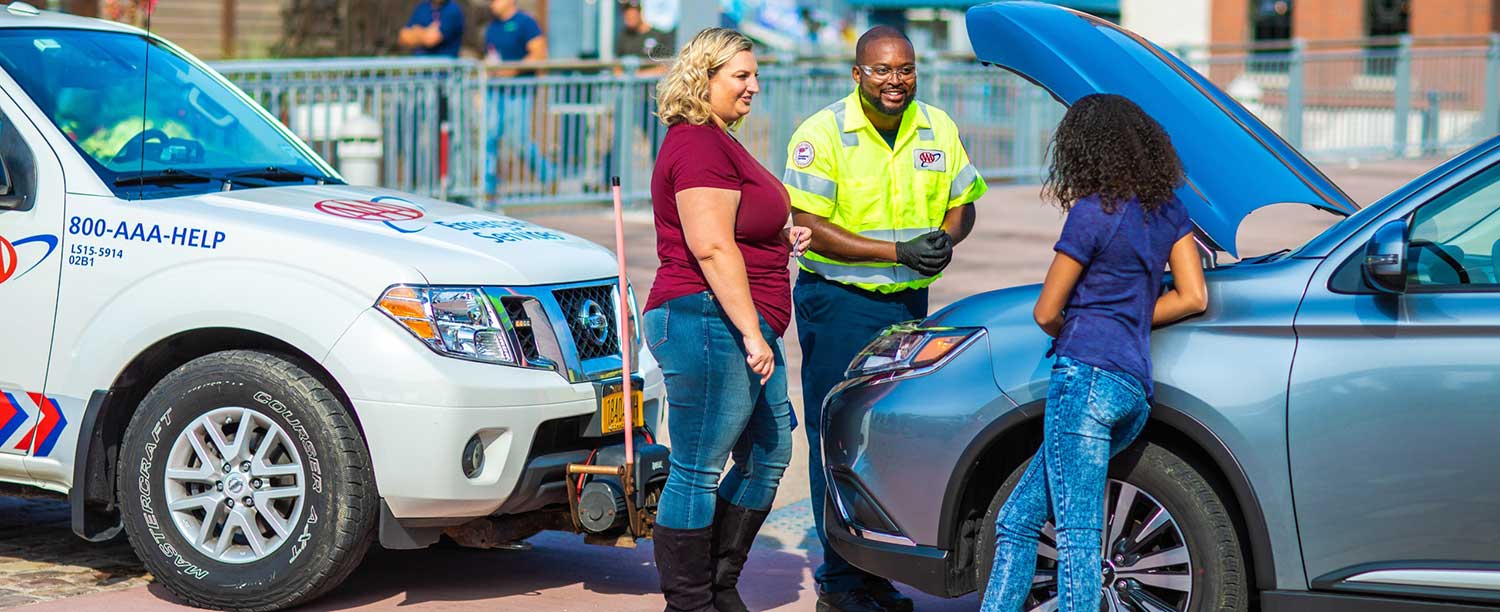How you fare when your vehicle fails is often a matter of how you respond. The decisions you make are important and can have positive or negative consequences. Fortunately, most problems are preventable.
Prevention and preparedness are key:
- Get in the habit of conducting periodic safety checks to make sure your vehicle is in good operating condition.
- A safety check includes tires, lights, belts, hoses, fluids and windshield wipers.
- Read your owner’s manual to clearly understand which dash lights or signals indicate your vehicle is not operating properly and what to do in such situations.
- Before a road trip, contact AAA to arrange for a free test of your vehicle’s battery, starting and charging system. This can help determine how much life is left in your battery and if any other components need repairs.
- Program your cell phone with emergency numbers, including that of your roadside assistance provider, and keep a backup written list in your glove compartment.
- Always carry a well-stocked emergency kit and familiarize yourself with the use of safety flares, warning triangles and other emergency equipment.
What to do in the event of a break down
Since surroundings, traffic patterns and vehicle hazards can vary, it’s important to evaluate your specific situation and react accordingly. The following steps are a good starting place:
- Note your vehicle’s location. If you encounter a problem while driving, make sure you are aware of your surroundings and general location. Know where you are in relation to a major exit or cross street and look for well-lighted areas. If you are on an interstate highway, note the mile marker, last exit number or nearest rest area.
- Assess the problem. While driving, be aware of and know how to respond to warning signs such as steering problems, unusual noises or steam or smoke coming from under the hood. If it’s a flat tire or you run out of gas, try not to panic. Signal, slow down gradually and carefully pull onto the shoulder of the road, avoiding any sudden maneuvers.
- Pull off the road. On most roads, you should exit onto the far right shoulder, as far off the road as possible while remaining on level ground. If you are driving on an interstate or multiple-lane highway with medians, you may consider the left shoulder, again pulling as far away from traffic as possible. If you exit the vehicle, never stand behind or directly in front of it to help avoid injuries if your car is struck by another vehicle.
- What if you cannot pull off the road? If your vehicle loses power and is inoperable, switch on safety/emergency flashers. Do not risk personal injury by attempting to push it to a safe location. If you cannot get your vehicle to a location away from traffic, or if you are uncertain about your safety and think your vehicle may get struck from behind, get out of the vehicle and move away from the road to a safer location.
- Alert other drivers. Make sure your vehicle is visible to other drivers, remembering that they may be traveling at a high rate of speed.
- Turn on the emergency flashers, especially at night or during inclement weather.
- Raise your vehicle’s hood. If you have a brightly colored handkerchief or scarf, tie it to the antenna or door handle, or hold it in place by closing it in a window.
- Place flares or warning triangles behind your car to direct oncoming traffic away from the vehicle.
- As a rule of thumb, place the first flare or triangle 10 feet directly behind the side of the vehicle closest to the road. Place the second 30-60 feet (longer distances as the posted speed limit increases) directly behind the vehicle, lining it up with the middle of the bumper. Position the third device 120-360 feet behind the vehicle’s right side. Always watch for oncoming traffic when placing warning devices.
- If you are experiencing a fuel leak or smell fuel fumes, do not ignite a flare or use anything that produces a spark or flame.
- Communicate your situation. Once you and any passengers are in a safe location, notify others of your vehicle breakdown. Make note of surroundings and landmarks, buildings or road signs.
- If you have a cell phone, immediately use it to call for help. Make the call from inside your vehicle if you are safely out of traffic. Otherwise, do so at a safe distance from the vehicle and roadway.
- Remain with your vehicle. Safety experts agree that under most circumstances if you are able to pull away from traffic, it is safest to remain in your vehicle until a law enforcement officer or road service provider arrives.
- In some circumstances, when there is no other alternative, you may need to rely on the help of a friendly motorist or passerby. Should this be your only alternative to get help, ask for identification including name, phone number and address before accepting assistance. Write this information down and leave it with another person, or in the vehicle, explaining where you are going, when you expect to return and what you hope to accomplish.
- If you choose to exit the vehicle, do so safely and well away from oncoming traffic and your vehicle. If possible, you and any passengers should exit through the side of the vehicle facing away from the road.
- If you choose to stay inside your vehicle, keep the windows almost closed and the doors locked. It’s very dangerous to lower your windows or open your vehicle doors to strangers. If a stranger does stop to offer help, ask the person to call for emergency road service.


